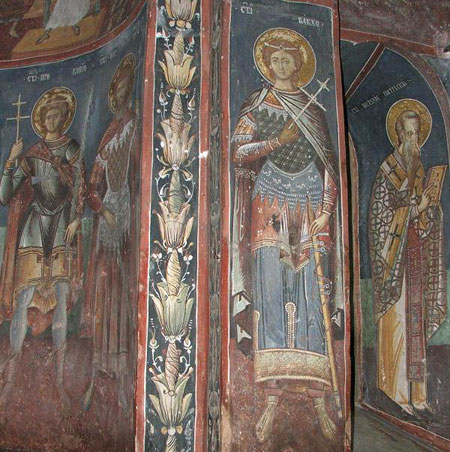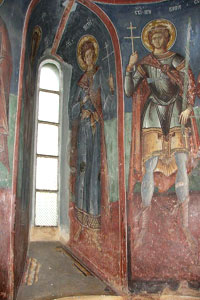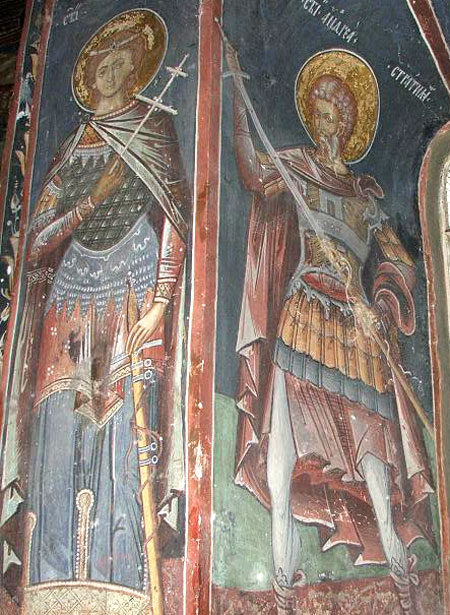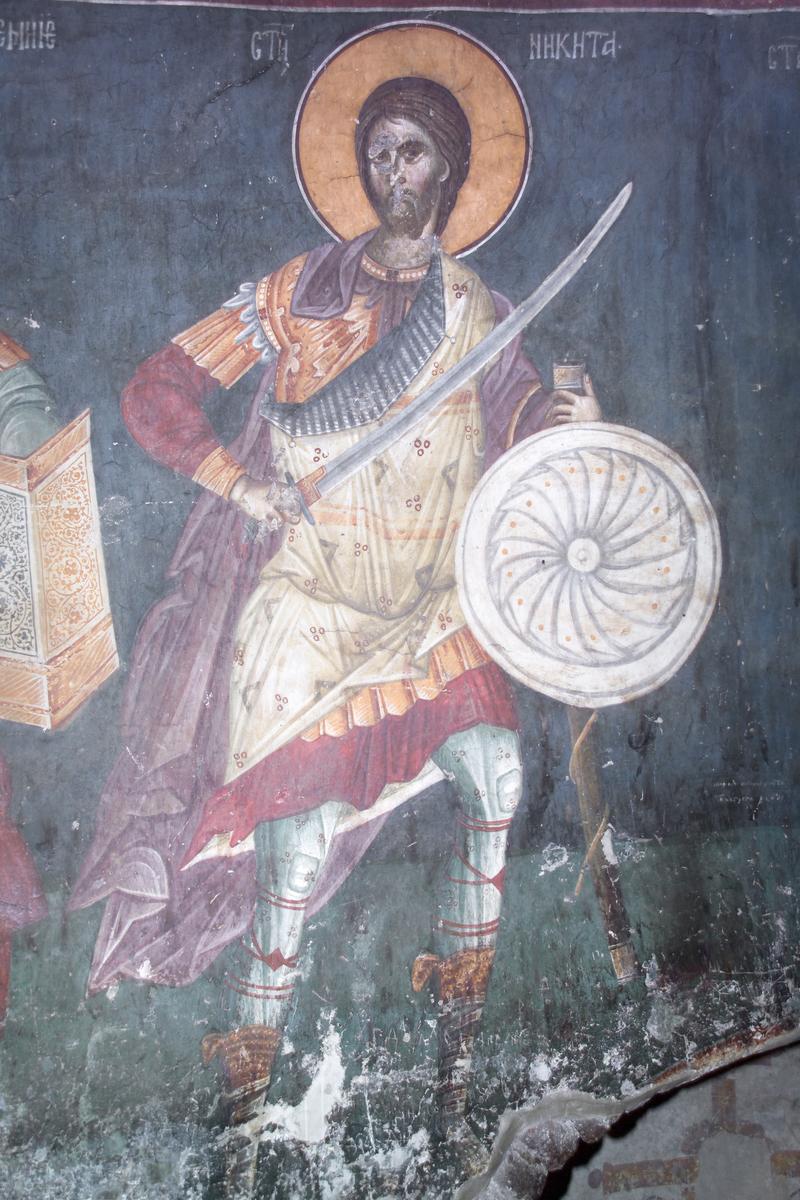
 |
|
|
|
|
#1 |
|
(deceased)
Join Date: Sep 2008
Location: Bavaria, Germany - the center of 15th and 16th century gunmaking
Posts: 4,310
|
- 15th century flail and crossbow from Sibiu
Hi Emanuel, Could you please give the full bibliographic data of the book that you got that picture from? Thank you in advance, Michael |
|
|

|
|
|
#2 |
|
Member
Join Date: Jul 2005
Location: Toronto, Canada
Posts: 1,242
|
Hi Michael,
My apologies for the late response, I havn't been very active on the forum and I didn't see your post. The source of the images is a small picture book called "Mileniul Romanesc, 1000 de Ani de Istorie in Imagini, Editura Litera, 2004". This is not a historical book and I'm weary of its accuracy. It doesn't contain much information. Regards, Emanuel |
|
|

|
|
|
#3 |
|
Member
Join Date: May 2010
Posts: 2
|
Hi to all of you,
it looks like now we are two Romanians on this. I have seen that you had a lot of comments and also shared a lot of information. History it is one of my hobbies for the last 25 years. I just want to make a few points here. The Cumans (especially the Black Cumans) were having some impact in Wallachia. Negru Voda (Negru means Black and voda is a shorter form of the voievod), one of the first known rullers in Wallachia is coming from the area of the Fagaras which it is a known area where many Black Cuman settled and as you can see in the map, some villages still keep some interesting names like Comanestii and Voievodenii.  The Cuman contribution to the establishment of the Wallachian state it is a topic extremely debated between the historians even today (during the communism era it was a taboo subject). In the battle of Posada between Basarab's Wallachian army and Charles's Hungarian army appear a ... recurved bow or Tartars bow as it is known in Wallachia. Also the Byzantine chronicler Laonic Chalcocondyl is mentioning that the shields of the Valachians were similar to the shields of Tartars.  Also, regarding the armors used in Wallachia. I think we can say it was a mix, but Wallachia and Moldavia were excellent customers for the ringmails sold by Venice (Italy). Mircea the Old it is known that he inherited an army of 10000 knights in ringmails made in Venice. Those knights were also mentioned during a jousting in Buda 1412. Two things to be highlighted here: 1) The size of the professional army is huge compared with the size of the country. 2) We are talking about knights here, which means a specific and very expensive warrior of the Middle Age. Something it is not right here with image of the peasants army! As you probably have seen already, in Romania the best place to see something like armors is only on the gravestones or churches frescoes. For Mircea the Old era (XIV century) weaponry, we must check the church made in his day, the church of the Cozia Monastery, where we can see the ringmails and a lot of spades.    .jpg) Regarding the passivity and the peace loving Wallachians/Moldavians that would be correct if we refer to it starting only with 1711 in Moldavia and 1716 in Wallachia when are imposed leaders of foreign nationality (Greeks) named Fanariot. Their first action was to make a law forbidding the weapons for all people. Till than the situation was totally different because both voievodes in Moldavia and Wallachia were known for asking that all people (at least the free ones, so forget about Gypsy warriors because they were slaves) to have weapons. Stephen the Great provided a list of equipment what the people should have when are called under arms (Polish chronicler: saber, bow and arrows) and Vlad the Impaler (Dracula) had impaled (what would you expect?  ) one of his soldiers because of the poor status of his shield and sword. ) one of his soldiers because of the poor status of his shield and sword.A good idea of the sword type used by Wallachians it is given by the old names for some administrative functions and by ... Polish chroniclers. Mare Spatar (Grand Spade Bearer) : majority of Romanians do not know today but "spata" is the archaic form of "spada" = spade (in german would be spatha). So the nobility was using spades (remember the frescoes from Cozia). Unfortunately not too many people can speak Romanian because this study could be interesting regarding the evolution of the weapons name during the centuries. Later, http://www.scribd.com/doc/29788274/P...cu-Elena-Roman LINK And finally, in the following link you may see some of the Moldavian weapons used during the Stephen the Great. Also a sabre from the XVth century in Fig3 unearthed near Suceava. LINK |
|
|

|
|
|
#4 |
|
Arms Historian
Join Date: Dec 2004
Location: Route 66
Posts: 9,896
|
Excellent post Lucian!!! and welcome to the forum!!!
 Its great to have another here from Romania, as this history is both complex and incredibly fascinating, and your insight is most valuable. Beautiful illustrations also, thank you for posting them. All the very best, Jim |
|
|

|
|
|
#5 |
|
Member
Join Date: Jul 2009
Location: Slovakia
Posts: 48
|
Great post Lucian and thank you very much for the splendid info!
Those beautiful frescoes are very similar (I dare to say almost identical) to those found in Kosovo and other places of former Yugoslavia. It appears Serbs similarly (as well as other adjacent ethnicities) to Wallachians used a mix of western and eastern military equipment. For example you'll find a military saint depicted with classic heater shield , lance and a sword on one hand but also a composite bow with a Kipcak/Cuman style quiver as well (in which the arrows are pointed arrowheads up):  Monastery Decani, Kosovo 1330-1350  Church of Saint Kliment , Macedonia cca. 1295 Sabres of both the classic steppe style (riveted hilts and small pommel caps) as well as "paramerions" (essentially weapons with sword hilts and curved blades) are present as well (furthermore Maces are common secondary weapon depicted, instead of the more western European war-hammers). There are two great websites that host a big number of photographs of the aforementioned "Yugoslav" frescoes http://www.srpskoblago.org/Archives/ and http://sankire.narod.ru/Balkani.html I have looked through most of the wall-paintings on the Srpsko Blago website so if anyone's interested I can point-out the relevant ones (with respect to arms and armour). Lucian in case you have some more info on the arms and armour from Wallachia/Moldavia etc. feel free to post it , id be very interested myself. It seems there were many similarities between the various south-eastern principalities and kingdoms. Kind Regards, Samuel |
|
|

|
|
|
#6 |
|
Member
Join Date: Dec 2004
Location: Bay Area
Posts: 1,615
|
It is debatable whether the warriors on the frescoes are Serb or Greek or Bulgarian. In fact, at 1295, Macedonia was not part of the Serbian Kingdom.
Given the common state entity and close ties between Walalchians, Bulgarians and Cumans in the 12-13th centuries, it is not surprising that the arms and armor were shared as well. When looking at frescoes, we also have to remember that the equipment depicted is also based on church cannons and on the artist's own images of how a warrior should look like. Some of the equipment may have been copied down from earlier frescoes, so pictorial evidence alone cannot be completely relied upon, and has to be examiend combined with archaeological finds, written sources, etc. Regards, Teodor |
|
|

|
|
|
#7 | |
|
Member
Join Date: Jul 2009
Location: Slovakia
Posts: 48
|
Quote:
the depiction of armour in particular seem to have had a great deal of anachronism (e.g. the continuous portrayal of scale/ lamellar armour).As to the ethnicity of the warriors saints I personally think its negligible as for example the Bulgarian 14th century version of manasses chronicle has illustrations with similar figures. Furthermore you'll find very similar/identical portrayal of warrior saints in Kosovar/Serbian frescoes. Coming back to the accuracy of the depiction of arms and armour, some pieces however do have novelties in them, especially in terms of weapons. You can see yelman-less sabres and "paramerions" as well as the cuman-style quivers in the first half of the 14th century , whereas the early 15th century fresco of a trio of warrior-saints (cca. 1408-1420) presents an interesting "development" ( manasija monastery)  Note the bow-case of the central figure , he has two arrows in it with its fletching pointed upwards , which is more characteristic of Anatolian Turks (there is an article on a similar matter by Russ Mitchell in volume 4 of journal of medieval military history). The rightmost figure of St Nikita sports a sabre with a quite visible yelmen, which is again more typical of later weapons. You can compare those with earlier depictions (such as the one in my earlier post) and with the depiction of St. Nicetas from Gracanica (1321-22)  Note the lack of yelmen as well as the "habaki" part between the hilt and the blade.. again a feature more characteristic of earlier sabres. Swords are sometimes presented in anachronistic way (some appearing even after two centuries e.g. you'll find an identical depiction of a sword from a 12th century fresco in a 14th century one etc.) but some are "modern" in their appearance ,e.g. pieces that have semi-curved cross-guard and even hand and a half grips. Those examples of sabres/quivers as well as swords are in my opinion a sign that not all of those fresco depictions are necessarily "outdated" or entirely fantastical. Some are filled with immense attention to detail that can in fact rival the art from Western Europe. Regards, Samuel |
|
|
|

|
|
|
#8 |
|
Member
Join Date: May 2010
Posts: 2
|
Actually a lot of very old churches, but especially the Cozia's church frescoes, are in the Serbian style. Mircea the Old had many relations and alliances with the Serbians. The style we can name it Serbian but I think it would be more correct to name it Byzantine.
Talking about Kossovo, Mircea the Old provided some troops (around 3000 soldiers it is mentioned in several recent articles an even in some history books but I found nothing from that era and I have no idea if were infantry, archers or light cavalry) for the Battle from Kossovo Polje in 1389. I suppose were light cavalry because were supposed to move really fast for a long trip. In that battle were so many nations that I am almost not surprised about the outcome whom everybody said that is their victory. I am even amazed that they made a cohesion between so many groups. Coming back to the Wallachian and especially the Moldavian swords, I found an interesting work related to the representation of Saint George on stove tiles from the fourteenth century and also an interesting conclusion: "One can also note the character of weapons depicted. Sabers appear on the tiles with St. George mostly in Wallachia (9), while there are only 2 from Moldavia and 1 in Transylvania. Unlike the sword, the sabre was hardly known in the medieval west. It was a more oriental type of weapon, re-introduced in South-Eastern Europe during the fifteenth century due to the conflicts with the Turks. This indicates that in Wallachia such oriental weapons were much more familiar in those times than in Moldavia or Transylvania." The study is at this LINK . |
|
|

|
 |
|
|